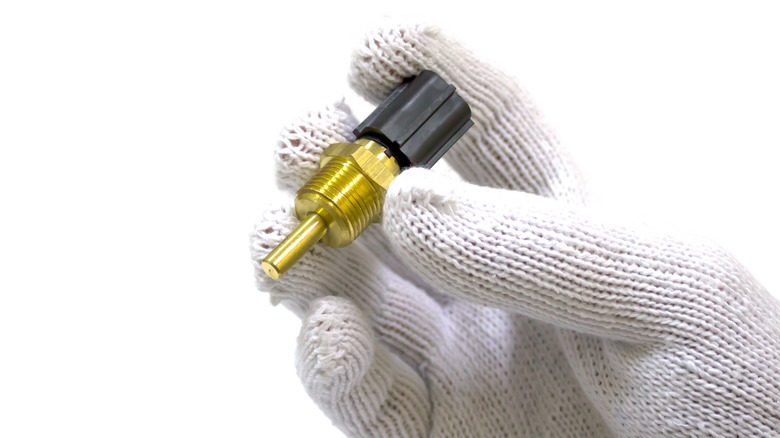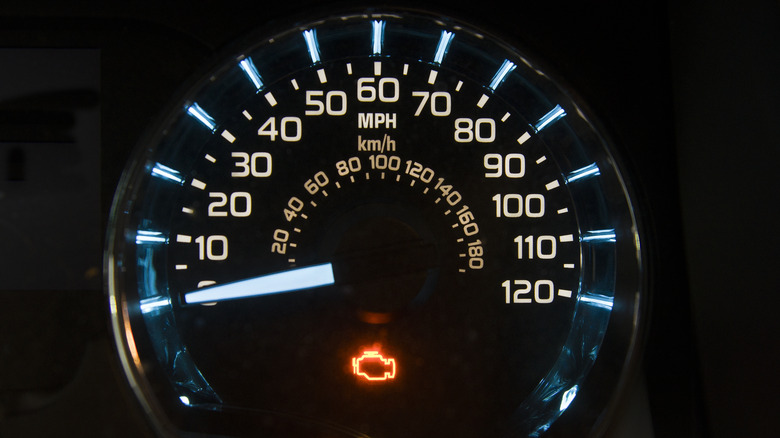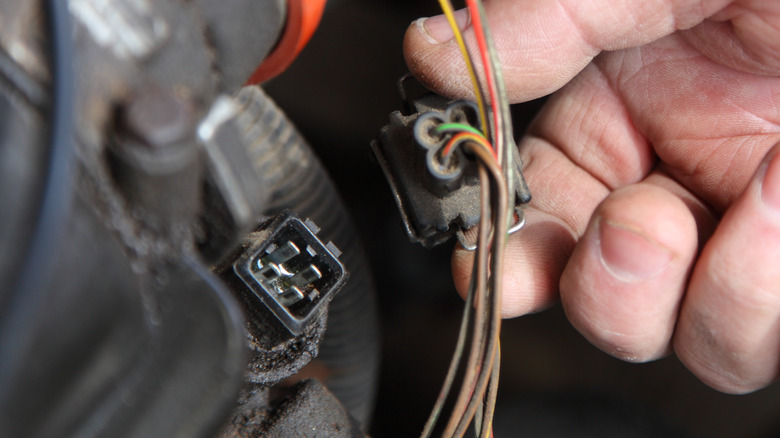4 Signs That Your Engine Coolant Temperature Sensor Is Bad (And The Cost To Fix It)
Virtually every modern car on the road is equipped with bells, whistles, and sensors designed to let you know when even the slightest thing is wrong with your vehicle. While any driver can appreciate a good, old-fashioned heads up regarding potential issues with their automobile, such sensors can be problematic when they malfunction, and that's particularly true of a vehicle's engine coolant temperature sensor.
Also referred to as an ECT sensor, a coolant temperature sensor is one of a vehicle's more vital safeguards against overheating as it directly gauges the temp of an automobile's coolant. For those not in the know, engine coolant's primary function is to prevent your engine from overheating. If the coolant is too hot, your engine is far more vulnerable to a catastrophic failure. Just as important, ECT sensors can also be used by the engine control module to gauge a vehicle's performance and initiate the use of cooling fans as needed.
Ensuring your coolant temperature sensor is functional feels like a no-brainer. Here are a few tell-tale signs that your ECT sensor might be bad.
Your check engine light is on
The good news is that there are a couple of other electronic sensors in your car that may alert you to a faulty engine coolant temperature sensor, and one of them is the check engine light. That particular light is the bane of any automobile owner's existence as it tends to signal that something bad has, or is about to happen to your engine. So, it is beyond essential that you get your vehicle to a mechanic whenever the light comes on, as it may help you diagnose a potentially catastrophic malfunction before it becomes one.
As it is, a bad engine coolant temperature sensor is not typically regarded as a catastrophic event in your engine's health. Perhaps more importantly, the cost for swapping in a new sensor doesn't tend to skew towards the high end of engine repairs, so learning that a bad ECT sensor is behind the check engine light may ultimately be good news for many, assuming you caught the problem before it caused any other major issues. Nonetheless, you will not know that a bad ECT sensor is the cause of the light unless you take your vehicle in for a diagnostic check or by scanning it yourself using a code reader.
Your vehicle's engine is running hot or the temp is fluctuating
It's safe to say that, apart from the check engine light, an automobile's temperature gauge warning light ranks among the most dreaded you can see on the dashboard. That's partly because when the engine overheating warning comes on, it tends to mean your engine is already in trouble and action needs to be taken.
But just like the check engine light, the engine overheat light may not signal a looming engine failure, as a faulty ECT sensor may be causing the temperature of your vehicle's engine to fluctuate or the engine to overheat. That's because a coolant temperature sensor may fail in a way that causes it to transmit hot signals to your car by mistake. Those hot signals may lead your car's onboard computer to counterbalance, and mixed signals can result in a misfire, shifting engine temperatures, and potentially even an overheated engine.
Again, given the stakes, a faulty engine coolant temperature sensor may be one of the better diagnoses an automobile owner can get when they see an overheating warning. Even still, auto owners should correct the issue as soon as possible when that light comes on, as failing to do so could lead to engine failure and high-priced repairs.
Your car is idling rough
Warning lights can be life and money savers for car owners, but there are a couple of non-light signs to watch out for that may signal your engine coolant temperature sensor is faulty. Chief among them is a rough idle when your car is turned on and stopped. Now, a rough idle could signal any number of issues within your engine. As it's also a sign that can be easy for drivers to overlook or even ignore when they are behind the wheel, it pays to be hyper-vigilant and keep an eye peeled for any irregular shimmy or shake when you pull up to a stoplight.
As for how the ECT sensor might affect your car's idling, a bum sensor could cause an adjustment to the engine's fuel mixture, and when that mixture is off balance, the result could easily lead to undue shaking or vibrating when you are idling. When that happens, it can indicate that your engine's coolant temperature sensor is faulty or has ceased functioning. Like any warning sign, it's important to take your vehicle in for a professional check-up the moment you feel that first shimmy or soon after. That, of course, also makes it important that you recognize the issue when it's happening. So, stay vigilant, people.
Black smoke is coming from the exhaust
Some automobile owners may not understand that smoke coming from your exhaust pipe is not a good sign. But different colors of smoke can mean very different things for the health of your engine and exhaust system. Black smoke billowing from your exhaust pipes signals that the fuel-to-air ratio in the engine is too heavy on fuel, making it impossible to burn it all away within the combustion chamber and thus leaving it to burn instead inside the exhaust pipe.
The usual suspects for such a failure are a faulty fuel regulator or a leaking fuel injector. However, a bad sensor like the ECT can also be the culprit, as inaccurate readings can transmit false information to a vehicle's computer, which leads your engine to raise the amount of fuel running through the engine. While the ensuing black smoke is both unsightly and unhealthy for drivers as well as the environment, the good news is that if a faulty ECT sensor is behind the issue, the problem should be resolved when you replace the sensor and the vehicle's fuel-to-air ratio is returned to normal. That makes it all the more important to take your car in for service when you see black smoke in the exhaust.
Cost of fixing an ECT sensor
Now that you know how to tell whether your engine coolant temperature sensor is failing, the question becomes what action you need to take to correct the problem. If we haven't been clear enough, you'll want to fix it as soon as possible, as an ECT sensor is a vital tool in ensuring your engine does not overheat. If you have a bum ECT sensor in your car, the most obvious thing to do is replace it with a new one. The good news is that a new coolant temperature sensor won't set you back too much coin, as you can pick one up from Auto Zone for about $16.49. However, the price can be considerably higher for a new ECT, depending on the make and model of your vehicle.
Purchasing a new ECT sensor is only half the battle, as it will still need to be installed in your car. If you're handy around an automobile engine, you can save a few bucks by installing it yourself. However, if you are uncomfortable performing engine work on your car, you'll need to consult a professional mechanic, and the cost of the repair will obviously rise once professionals are involved. The work needs to be done nonetheless, as no vehicle should operate for long without a functional engine coolant temperature sensor.





